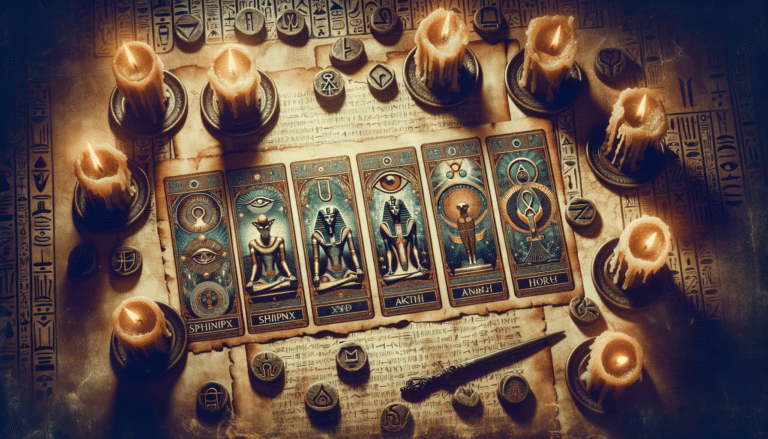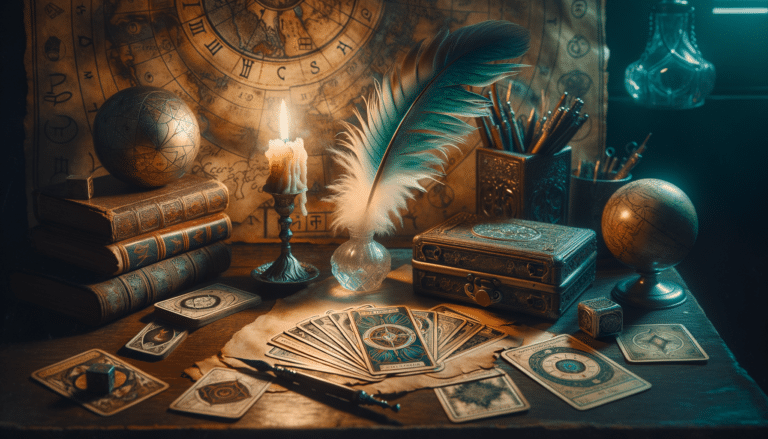Tarot From Game to Divination – The Evolution Explained
Nearly 75% of tarot readings today are sought for self-guidance, but you might be surprised to learn that tarot’s origins are steeped in play, not prophecy. You see, in the 15th century, tarot cards were primarily for games, with no mystical associations.
As you delve into the Renaissance, you’ll notice artwork rich with symbolic imagery, which sparked curiosity and contemplation beyond mere entertainment. It’s during this time that we began to see a shift in tarot from game to divination and the mystical.
You’re now looking at a world where Renaissance symbolism, combined with the rise of Hermeticism – a philosophy that includes astrology, alchemy, and theurgy – paved the way for tarot’s transformation.
Understanding how these historical elements intertwined helps you grasp why tarot drifted from leisurely pastimes into the hands of diviners, evolving into a tool for introspection and guidance you recognize today.
Key Takeaways
- Tarot cards initially emerged as a card game among the wealthy in 15th-century Italy.
- The shift towards mysticism and Renaissance symbolism transformed tarot cards into symbols for personal journeys and universal truths.
- Hermeticism played a pivotal role in imbuing tarot cards with esoteric significance, connecting them to alchemy, astrology, and the Kabbalah.
- The integration of tarot into esoteric traditions during the 18th and 19th centuries solidified its role as a tool for divination and representation of mystical truths.
Origins of Tarot Cards
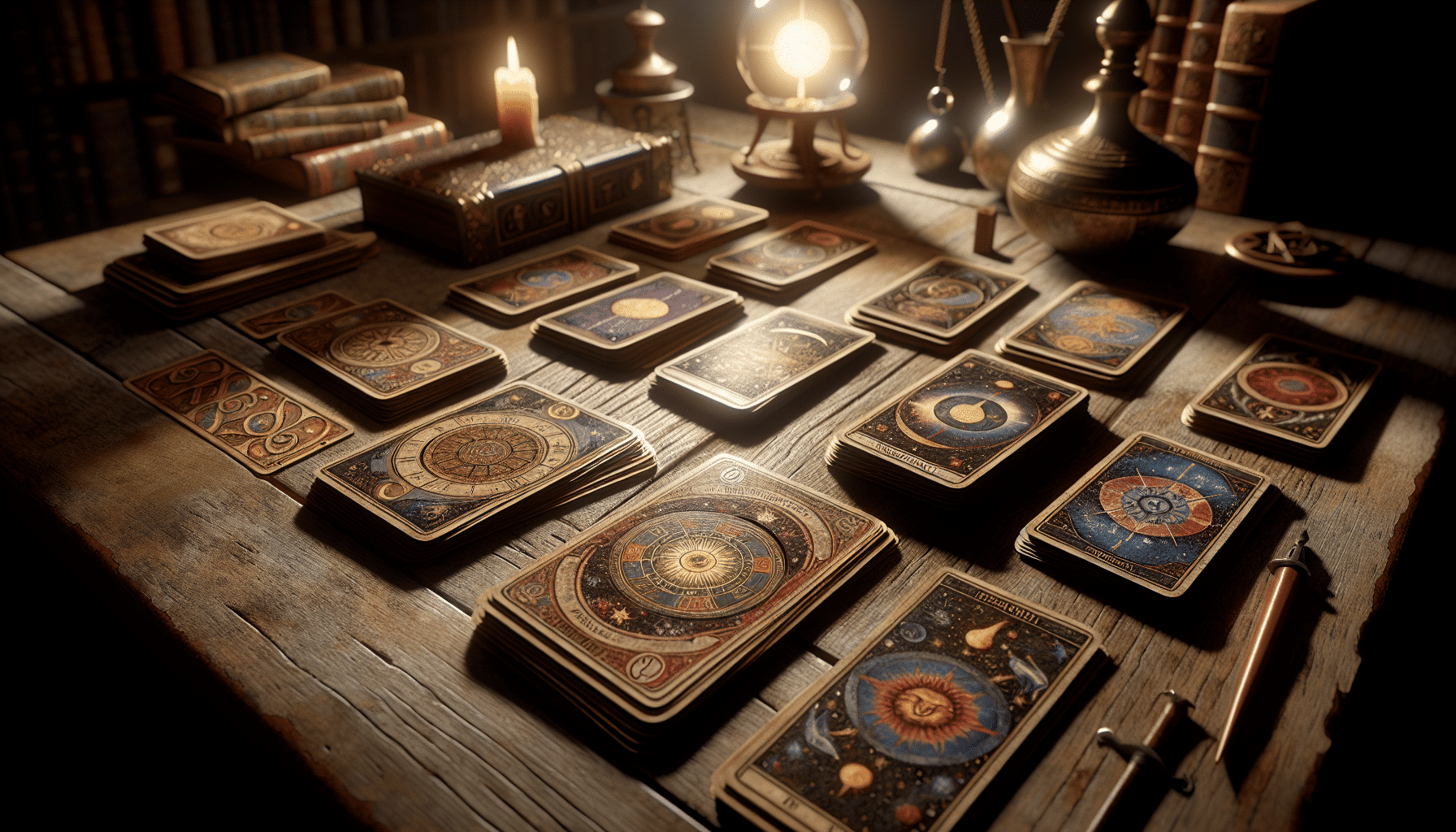
Why did you know that tarot cards, originally known as tarocchi, first emerged in 15th-century Italy as a card game among the wealthy? It’s fascinating to consider the evolution of their purpose from leisure to spiritual guidance.
The card creation process during this time was intricate and labor-intensive, typically involving hand-painting, which made decks expensive and exclusive. Wealthy patrons often commissioned artists for personalized deck designs, which included a variety of symbolic imagery that reflected their interests and values.
These bespoke decks consisted of two types of cards: the major arcana, featuring allegorical figures, and the minor arcana, resembling a modern deck of playing cards with four suits. However, the addition of trumps, or the major arcana, distinguished tarot from other card games. Over time, the symbolic pictures on the cards began to take on more profound meanings, leading to their use in divination.
As you delve into tarot’s history, you’ll realize that the transition from game to mystical tool was gradual. Deck design played a critical role in this shift, as the rich iconography provided fertile ground for interpretative methods that eventually turned tarot into a conduit for insight and reflection.
Tarot’s Early Gameplay
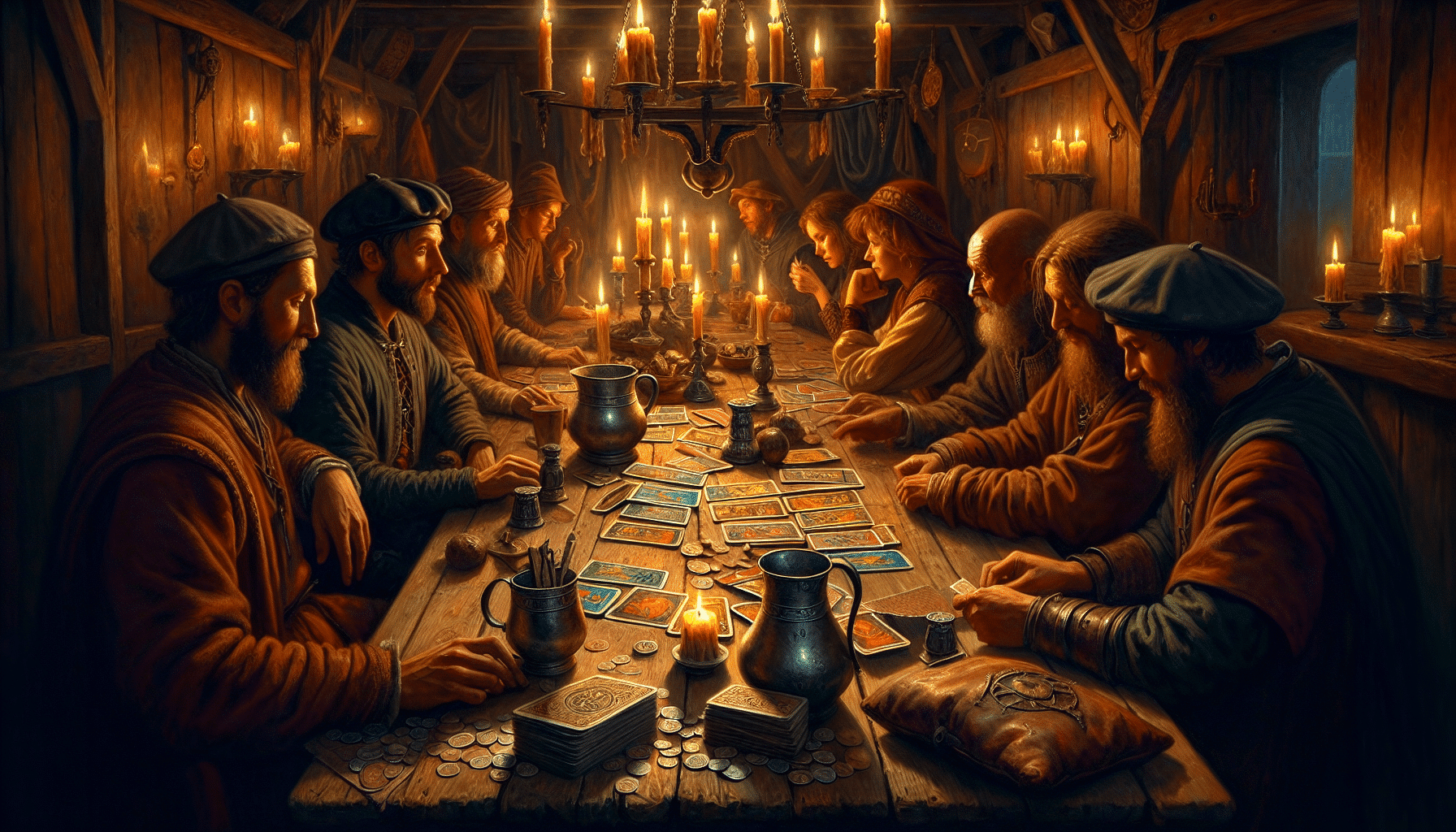
As you move from the origins of tarot into exploring its early gameplay, you’ll find that the initial rules were akin to those of other card games popular among European nobility. The deck comprised suits and trump cards, with the latter holding special significance and power in gameplay. Your aim was to tactically outplay your opponents, employing card strategies that capitalized on both the hierarchical nature of the trumps and the timing of each play.
Mastering playing techniques was crucial. You’d to know when to hold back your stronger cards and when to seize an opportunity, leading with a high trump or a suit card that could potentially capture the trick. Like modern card games, reading your opponent’s intentions and managing your own hand were essential skills.
The game of tarot wasn’t just about luck; it was about finesse and the clever management of resources – the cards in your hand. Each card had a role, and recognizing the best moment to utilize each one distinguished the novices from the seasoned players. Understanding these nuances of early tarot gameplay gives you a glimpse into why the game was so engaging and how it might have eventually lent itself to a more mystical purpose.
Check out our Tarot Decks here…
Shift Towards Mysticism
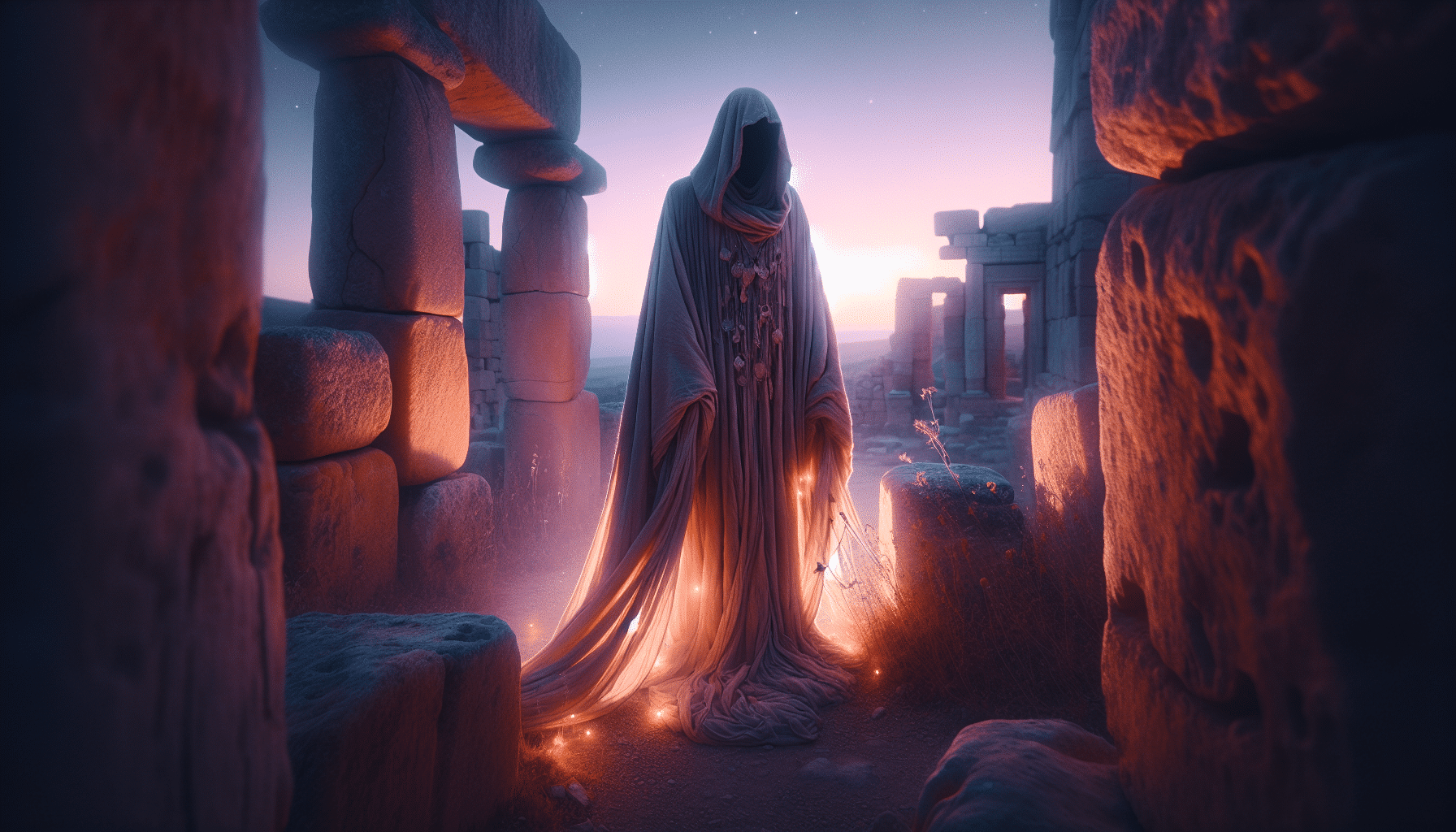
Every tarot card you skillfully played in the game’s early days carried with it the seed of symbolism that would eventually blossom into a tool for divination. As the years passed, the mystical allure of tarot’s vivid images took root in the collective consciousness. You might wonder how a simple pastime transitioned into a profound method for psychic readings.
The shift towards mysticism wasn’t abrupt; it was a gradual intertwining of cultural, spiritual, and philosophical threads. You see, the very essence of tarot cards as multifaceted symbols made them ripe for reinterpretation beyond card games. They became mirrors reflecting personal journeys and universal truths.
To make it clearer, let’s look at a simple table illustrating this transition:
| Era | Perception of Tarot | Use |
|---|---|---|
| Early Days | Entertainment | Card Games |
| Middle Period | Symbolic Potential | Transitional Object |
| Modern Times | Mystical Tool | Psychic Readings |
This table encapsulates the evolution of tarot from mere game pieces to conduits of insight. Today, when you shuffle the deck, you’re not just playing a game; you’re tapping into a centuries-old tradition that connects you to a deeper understanding of yourself and the world around you.
Learn more with these best tarot books here…
Renaissance Symbolism

You’ll discover that the Renaissance period imbued tarot cards with rich symbolism, transforming them from playful images into profound archetypes. This era, renowned for its revival of classical philosophy and arts, saw tarot imagery steeped in layers of meaning. Each card became a vessel for arcane allegories, reflecting the complex human experience through esoteric artistry. As a result, tarot cards transitioned from mere playing pieces to tools of introspection and guidance.
Here’s how Renaissance symbolism played a pivotal role:
- Iconography: The images on the cards borrowed heavily from religious and mythological iconography, infusing each card with deeper significance.
- Numerology and Astrology: Numbers and celestial bodies associated with the cards provided an additional dimension of meaning, linking them to the cosmic order.
- Cultural Values: The virtues and moral lessons of the time were encoded into the cards, offering reflective insights into personal and societal issues.
In embracing these symbolic elements, tarot cards became more than just a game. They turned into a mirror, reflecting the inner workings of the psyche and the broader strokes of the human condition. As you delve deeper, you’ll see how every card whispers a story, inviting you to uncover the mysteries within.
Learn even more secrets of tarot history here…
Tarot and Hermeticism

As you explore Tarot’s transition from pastime to prophecy, you’ll find that Hermetic principles cast a long shadow over its evolution.
The cards brim with symbols reflecting mystical ideas, each image a potential wellspring of esoteric meaning.
Understanding Tarot’s hermetic ties offers insights into why it’s become a tool for divination.
Hermetic Principles Influence
Within the journey from parlor entertainment to mystical practice, you’ll find that Hermeticism played a pivotal role in imbuing tarot cards with esoteric significance. The arcane roots of tarot began to intertwine with the principles of Hermeticism, catalyzing an esoteric transition that forever altered the tarot’s purpose and use.
Here’s how Hermeticism influenced the tarot:
-
Correlation with Alchemy: The symbolism within tarot was seen to reflect alchemical processes, suggesting a transformative journey akin to turning lead into gold.
-
Astrological Associations: Each tarot card began to be linked with astrological bodies and phenomena, deepening their divinatory meaning.
-
Kabbalistic Elements: The tarot’s structure and imagery incorporated aspects of the Kabbalah, infusing the cards with layers of mystical interpretation.
Symbolism in Tarot
The intricate symbolism of tarot cards reflects Hermetic principles, guiding you through a rich tapestry of metaphysical concepts and universal truths. As you delve into the card artwork, you’ll notice that each image is a compendium of symbols, each with its own historical and mystical significance. These symbols aren’t just for show; they’re the keys to understanding the deeper Arcana interpretations.
Look closer, and you’ll see that the tarot deck is divided into the Major and Minor Arcana, each layer unfolding secrets of esoteric wisdom. The Major Arcana, in particular, is rife with allegorical images that resonate with Hermetic themes, offering you insights into cosmic laws and the human psyche.
As you explore, you’ll find that the tarot is a mirror reflecting the perennial wisdom encoded within the universe.
Tarot’s Mystical Interpretation
You’ll discover that each tarot card holds a myriad of Hermetic insights, bridging your understanding from the physical to the mystical realms. The card origins, steeped in allegorical imagery, serve as more than just a game; they’re gateways to higher consciousness. As you delve into tarot’s transformation, you’ll find that divination methods are deeply intertwined with Hermeticism. This ancient wisdom tradition teaches that the physical and spiritual worlds are interconnected, and tarot cards can be the keys to unlocking this sacred knowledge.
-
Symbolic Language: Each card is a book of wisdom, written in the universal language of symbols.
-
Divinatory Tools: Tarot is used to navigate life’s mysteries, offering insights and guidance.
-
Hermetic Connection: The principles of as above, so below are woven into the fabric of tarot practice.
Rise of Occult Tarot From Game To Divination Tool

You may not realize that tarot’s transformation into an occult tool was significantly influenced by 18th-century European mysticism. This period marked a notable shift in the card evolution, as intellectuals and mystics began to see deeper, symbolic meanings in the images and numbers on tarot cards. The occult popularity surged with the belief that these cards held keys to ancient wisdom and could unlock the secrets of the universe.
As you delve into the history, you’ll find that tarot’s mystical pivot coincided with the rise of esoteric societies and the revival of Hermetic philosophy, which embraced the concept of an interconnected cosmos. This philosophical backdrop was ripe for the tarot’s reinvention. Scholars like Antoine Court de Gébelin asserted that tarot cards weren’t mere playthings but a pictorial representation of mystical truths.
These ideas seeded the ground for the tarot’s metamorphosis from a parlor game into a tool for divination. By the 19th century, occultists such as Eliphas Levi integrated tarot into their practices, solidifying its role within the esoteric tradition. They imbued the cards with astrological, kabbalistic, and alchemical symbolism, which continue to inform readings today, shaping your understanding of the tarot’s enigmatic allure.
Modern Tarot Practices

While you explore tarot’s rich history, it’s essential to understand how modern practices have evolved from divination rituals into a tool for self-reflection and guidance. Today, the tarot deck isn’t only a mystical symbol but a versatile instrument for personal growth and decision-making. The cards serve as mirrors, reflecting your inner thoughts, feelings, and the potential paths that lie ahead.
To help you appreciate the nuances of current tarot use, consider how these practices are applied:
-
Card layouts: Specific patterns, such as the three-card spread for past, present, and future, or the Celtic Cross for a more detailed reading, structure the narrative the cards tell.
-
Psychic readings: Some tarot readers combine their intuitive abilities with the symbolism of the cards to offer insights that might feel remarkably personal and relevant.
-
Digital platforms: With technology’s embrace, tarot has gone online, allowing for virtual readings and apps that help you interpret the cards’ meanings at your convenience.
Whether you’re seeking spiritual clarity, psychological insight, or simply a fresh perspective, tarot’s modern practices offer a unique blend of ancient tradition and contemporary application. You can engage with the cards as deeply as you wish, crafting an experience that’s as meaningful as it’s enlightening.
Conclusion
In the end, you’ve seen how the tarot’s journey, like the winding river of time, flowed from playful origins to mystical shores.
Through Renaissance symbolism and Hermetic whispers, it bloomed into an occult garden, rich with divinatory secrets.
Today, you wield these cards, not just for a game, but as a mirror reflecting the hidden alcoves of the soul, a testament to the human yearning to unravel the tapestry of fate.
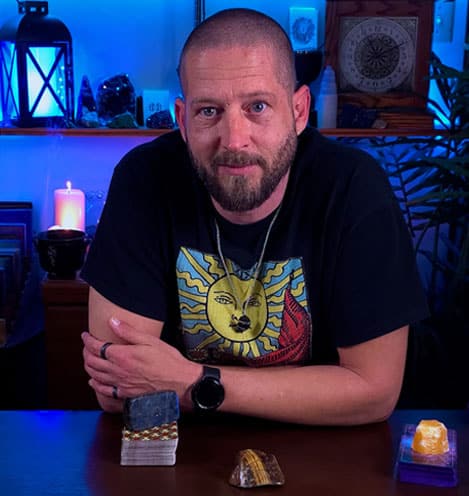
About The Author – Allen Hill
Allen Hill, the force behind Unknown Truth Tarot, has a YouTube following 6-times bigger than the population of his hometown, Miamisburg, Ohio. From his spiritually rich blog on Tarot and crystals to his role as CEO of The Unknown Truth Tarot Metaphysical Shop, Allen’s passion for the metaphysical shines through.
A master Tarot reader and “crystal junkie,” Allen is also a devoted dad to Dylan, 10, and Destiny, 24. When he’s not immersed in the world of Tarot and crystals, he enjoys poker and video gaming sessions, often humorously outplayed by Dylan.
Follow Allen on Twitter, Instagram, Facebook, TikTok, and subscribe to his Unknown Truth Tarot YouTube channel to join him on a journey of spiritual growth and self-discovery.



